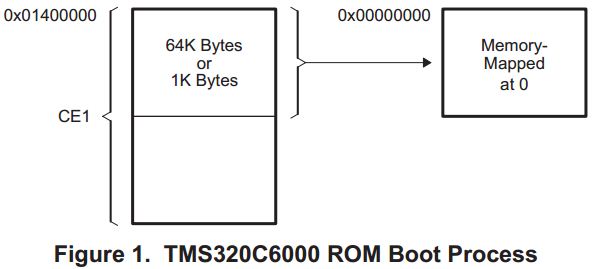本文主要简单记录C6000在启动装载过程和中断向量表的配置。
1. Bootloader
如上图, (1)在Device Reset阶段: 设备初始化为默认状态,大部分三态输出都配置为高阻态。 (2)在CPU Reset阶段: 从RS上升沿处开始(这个时候,根据HD[4:3]配置启动模式,HD8配置大小端模式,CLKMODE配置输入时钟源,根据HPI_EN配置外设功能),处理器检查启动模式HD[4:3],启动bootloader程序。 EDMA自动将CE1开始位置的1KB代码拷贝到内部程序存储器的0地址。
(3)RESET信号恢复高电平,CPU从内存0地址处开始运行程序
2. Interrupt Vector Table(Interrupt Service Table, IST)
处理器在RESET为低电平时复位,在RESET的上升沿,启动配置被锁定,开始从0地址处执行程序。一旦ROM启动完成(将外部ROM的1KB程序拷贝到内存0地址完成),寄存器初始化为默认值,程序计数器PC装载复位中断向量(复位中断向量需要在0地址处),CPU开始从0地址开始执行,这个地址称为复位向量。 默认的,中断服务表(IST)也在0地址处。IST是中断向量的一个集合,当CPU中断发生时,PC自动通过中断向量跳转到对应的中断服务程序。每个中断向量都是8个字(WORD)对齐。IST可以重映射到任意的以0x400-byte对齐的位置,但需要修改中断服务表指针(ISTP),在复位时,ISTP初始化为0值,IST首地址与复位向量对齐。 (1)创建中断向量表 IST由32个服务向量组成,每个向量对应一个CPU中断,特殊的:中断号0对应复位向量,中断号1对应不可屏蔽中断(NMI)。中断4~15对应各种信号事件的中断。中断号为n的中断向量的地址为
比如,ISTP重定位到0x1000,中断号为4的中断向量地址为Addr=0x1000+0x20*4=0x1080。 每个中断向量必须在8条指令内完成,若无法在8条指令内完成,必须将一些工作放到中断服务程序(Interrupt Service Routine, ISR)中完成。
当使用-c或-cr链接器选项时,DSP的C编译器自动的创建了函数_c_int00,这个函数对应C程序的入口地址,复位向量必须跳转到_c_int00地址处。当C程序遇到一个CPU中断时,在中断向量表中或中断服务程序中要使用的CPU寄存器都将先被压入堆栈,一旦中断服务程序完成,堆栈中的值弹出到对应的寄存器,继续执行原C程序。 中断服务程序需要使用关键字interrupt声明,
中断服务程序没有返回值,也没有参数,interrupt的功能就是在执行该中断服务程序前自动将寄存器压栈,执行完后自动的弹栈。
1. Bootloader

如上图, (1)在Device Reset阶段: 设备初始化为默认状态,大部分三态输出都配置为高阻态。 (2)在CPU Reset阶段: 从RS上升沿处开始(这个时候,根据HD[4:3]配置启动模式,HD8配置大小端模式,CLKMODE配置输入时钟源,根据HPI_EN配置外设功能),处理器检查启动模式HD[4:3],启动bootloader程序。 EDMA自动将CE1开始位置的1KB代码拷贝到内部程序存储器的0地址。

(3)RESET信号恢复高电平,CPU从内存0地址处开始运行程序
2. Interrupt Vector Table(Interrupt Service Table, IST)
处理器在RESET为低电平时复位,在RESET的上升沿,启动配置被锁定,开始从0地址处执行程序。一旦ROM启动完成(将外部ROM的1KB程序拷贝到内存0地址完成),寄存器初始化为默认值,程序计数器PC装载复位中断向量(复位中断向量需要在0地址处),CPU开始从0地址开始执行,这个地址称为复位向量。 默认的,中断服务表(IST)也在0地址处。IST是中断向量的一个集合,当CPU中断发生时,PC自动通过中断向量跳转到对应的中断服务程序。每个中断向量都是8个字(WORD)对齐。IST可以重映射到任意的以0x400-byte对齐的位置,但需要修改中断服务表指针(ISTP),在复位时,ISTP初始化为0值,IST首地址与复位向量对齐。 (1)创建中断向量表 IST由32个服务向量组成,每个向量对应一个CPU中断,特殊的:中断号0对应复位向量,中断号1对应不可屏蔽中断(NMI)。中断4~15对应各种信号事件的中断。中断号为n的中断向量的地址为

比如,ISTP重定位到0x1000,中断号为4的中断向量地址为Addr=0x1000+0x20*4=0x1080。 每个中断向量必须在8条指令内完成,若无法在8条指令内完成,必须将一些工作放到中断服务程序(Interrupt Service Routine, ISR)中完成。
.sect vectors
RESET: MVK .S2 Start, B0 ; Load Start address
MVKH .S2 Start, B0 ; Load Start address
B .S2 B0 ; Branch to start
NOP
NOP
NOP
NOP
NOP
NMI_ISR: MVK .S2 Nmi_isr, B0
MVKH .S2 Nmi_isr, B0
B .S2 B0
NOP
NOP
NOP
NOP
NOP上面是包含了复位和不可屏蔽中断的中断向量表的一个例子,主要是完成一个跳转到中断服务程序的功能。
(2)中断服务程序(ISR)当使用-c或-cr链接器选项时,DSP的C编译器自动的创建了函数_c_int00,这个函数对应C程序的入口地址,复位向量必须跳转到_c_int00地址处。当C程序遇到一个CPU中断时,在中断向量表中或中断服务程序中要使用的CPU寄存器都将先被压入堆栈,一旦中断服务程序完成,堆栈中的值弹出到对应的寄存器,继续执行原C程序。 中断服务程序需要使用关键字interrupt声明,
interrupt void myISR(void)
{
/* Code for myISR */
…
}中断服务程序没有返回值,也没有参数,interrupt的功能就是在执行该中断服务程序前自动将寄存器压栈,执行完后自动的弹栈。
*********************************************************************************
* vecs.asm
* Copyright 2003 by SEED Electronic Technology Ltd.
* All rights reserved. Property of SEED Electronic Technology Ltd. *
* Designed by: Hongshuai.Li *
*********************************************************************************
*------------------------------------------------------------------------------
* Global symbols defined here and exported out of this file
*------------------------------------------------------------------------------
.global _vectors
.global _c_int00
.global _vector1
.global _vector2
.global _vector3
.global _vector4
.global _vector5
.global _vector6
.global _vector7
.global _c_int08 ; Hookup the c_int08 ISR in main()
.global _vector9
.global _vector10
.global _vector11
.global _vector12
.global _vector13
.global _vector14
.global _vector15
*------------------------------------------------------------------------------
* Global symbols referenced in this file but defined somewhere else.
* Remember that your interrupt service routines need to be referenced here.
*------------------------------------------------------------------------------
.ref _c_int00
*------------------------------------------------------------------------------
* This is a macro that instantiates one entry in the interrupt service table.
*------------------------------------------------------------------------------
VEC_ENTRY .macro addr
STW B0,*--B15
MVKL addr,B0
MVKH addr,B0
B B0
LDW *B15++,B0
NOP 2
NOP
NOP
.endm
*------------------------------------------------------------------------------
* This is a dummy interrupt service routine used to initialize the IST.
*------------------------------------------------------------------------------
_vec_dummy:
B B3
NOP 5
*------------------------------------------------------------------------------
* This is the actual interrupt service table (IST). It is properly aligned and
* is located in the subsection .text:vecs. This means if you don't explicitly
* specify this section in your linker command file, it will default and link
* into the .text section. Remember to set the ISTP register to point to this
* table.
*------------------------------------------------------------------------------
.sect ".text:vecs"
.align 1024
_vectors:
_vector0: VEC_ENTRY _c_int00 ;RESET
_vector1: VEC_ENTRY _vec_dummy ;NMI
_vector2: VEC_ENTRY _vec_dummy ;RSVD
_vector3: VEC_ENTRY _vec_dummy
_vector4: VEC_ENTRY _vec_dummy
_vector5: VEC_ENTRY _vec_dummy
_vector6: VEC_ENTRY _vec_dummy
_vector7: VEC_ENTRY _vec_dummy
_vector8: VEC_ENTRY _c_int08 ; Hookup the c_int08 ISR in main()
_vector9: VEC_ENTRY _vec_dummy
_vector10: VEC_ENTRY _vec_dummy
_vector11: VEC_ENTRY _vec_dummy
_vector12: VEC_ENTRY _vec_dummy
_vector13: VEC_ENTRY _vec_dummy
_vector14: VEC_ENTRY _vec_dummy
_vector15: VEC_ENTRY _vec_dummy
*------------------------------------------------------------------------------
********************************************************************************
* End of vecs.asm
********************************************************************************上面是一个实际使用的C6713的中断向量表的汇编文件(vecs.asm),其中定义了全部15个中断向量,复位向量跳转到_c_int00地址,8号中断向量跳转到_c_int08函数地址,在C主程序中应该做如下定义,
/*
* interrupt function
*/
interrupt void c_int08(void)
{
}另外,由于在C程序中的PC跳转到中断向量地址是远跳转,因此有时需要在C程序中声明中断向量地址为远地址,如下,
extern far void vectors();其中的vectors()表示中断向量表的起始地址(汇编中使用了_vectors)。
注意:C中的变量和函数对应到汇编中都多了一个下划线(_),编译器在将C编译成汇编时都会自动添加下划线。